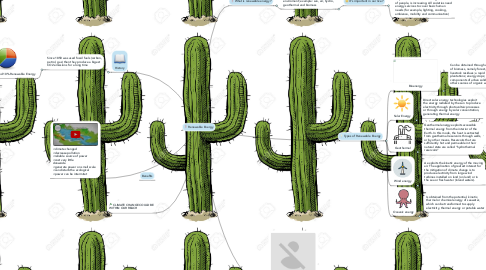
1. History
1.1. Since 1850 was used fossil fuels (carbon, petrol, gas) then they produce a bigest CO2 emissions for a long time
1.1.1. 90% fossil fuel and 10% Renewable Energy
2. <climete changed <decrease pollution <reliable source of power <cost very little donwside <generate power on small scale <can disturb the ecological <power can be intermitet
3. CLIMATE CHANGE COULD BE WITHIN OUR REACH
4. Benefits
5. What is renewable energy?
5.1. It's alternative more clean or the enviroment; example: sun, air, hydro, geothermal and biomass
5.1.1. It's important in our live?
5.1.1.1. The demand for energy and related services, with a view to social and economic development and to the improvement of the well-being and health of people, is increasing. All societies need energy services to cover basic human needs (for example, lighting, cooking, ambience, mobility and communication)
6. Types of Renewable Energy
6.1. Bioenergy
6.1.1. Can be obtained through various sources of biomass, namely forest, agricultural or livestock residues; a rapid rotation of forest plantations; energy crops; organic components of urban solid waste, and other sources of organic waste
6.2. Solar Energy
6.2.1. Direct solar energy technologies exploit the energy radiated by the sun to produce electricity through photovoltaic processes or through energy by solar concentration, generating thermal energy
6.3. Geothermal
6.3.1. Geothermal energy exploits accessible thermal energy from the interior of the Earth. In this mode, the heat is extracted from geothermal reservoirs through wells, or by other means. Reservoirs that are sufficiently hot and permeable in their natural state are called "hydrothermal reservoirs"
6.4. Wind energy
6.4.1. A exploits the kinetic energy of the moving air. The application of greatest interest for the mitigation of climate change is to produce electricity from large wind turbines installed on land (on land) or in the sea or fresh water (inland waters).
6.5. Oceanic energy
6.5.1. Is obtained from the potential, kinetic, thermal or chemical energy of seawater, which can be transformed to supply electricity, thermal energy or potable water
